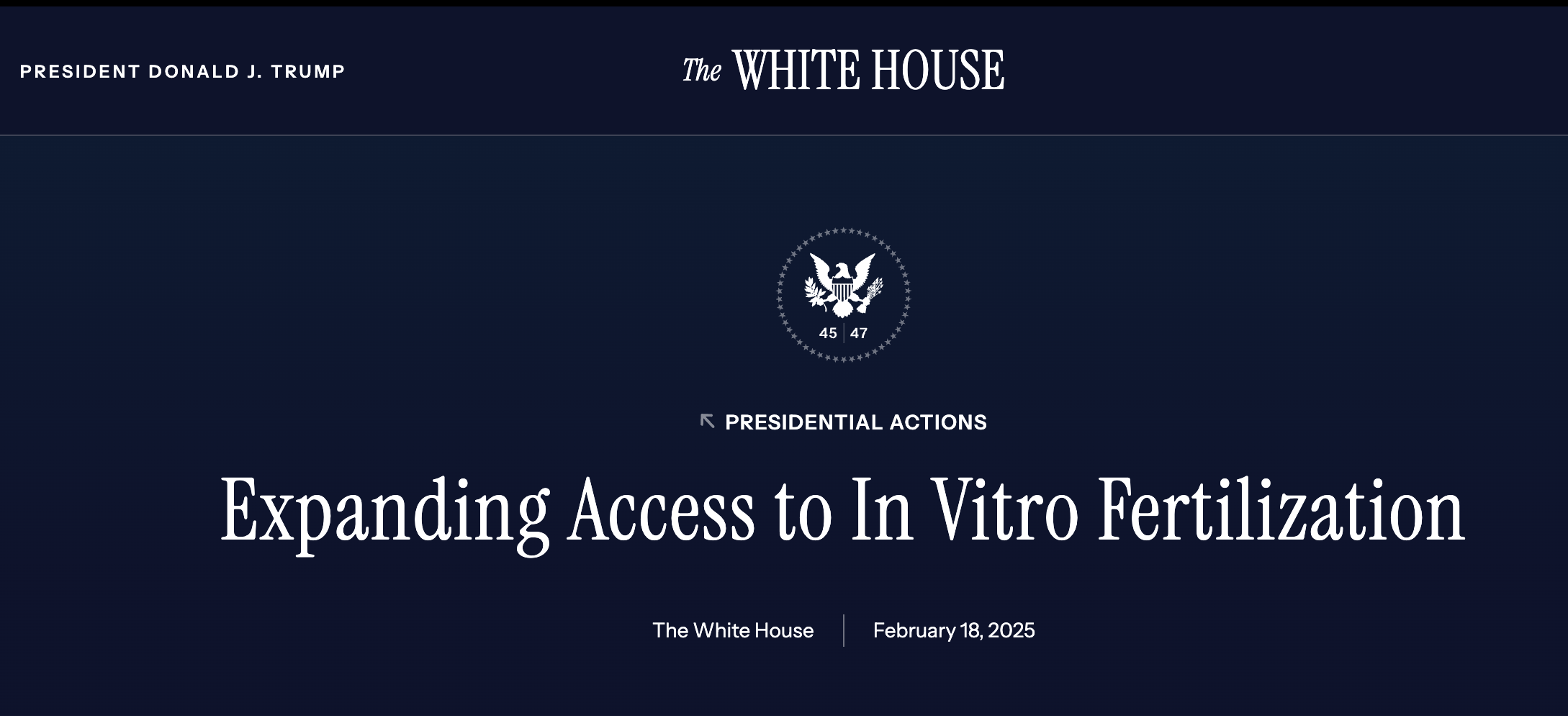Trump IVF Executive Order: What It Means for Fertility Patients

In February 2025, President Donald Trump signed an executive order titled “Expanding Access to In Vitro Fertilization (IVF).”
This order directs the White House Domestic Policy Council to come up with policy proposals to lower IVF costs and protect access.
The order instructs that, within 90 days, recommendations will be submitted addressing how to reduce both out-of-pocket costs and burdens on health plans.
What the order does and does not say
- The executive order does not establish mandatory coverage for IVF under health insurance plans.
- It calls for policy proposals, which are suggestions rather than regulations bound by law.
- The fact sheet accompanying the order states its goal is to “protect IVF access and aggressively reduce out-of-pocket and health plan costs for such treatments.”
What’s happened since the order?
- March 2025 Fertility Providers Alliance Meeting: The Fertility Providers Alliance (FPA) met with White House staff on March 27 to discuss IVF policy options, including reducing financial obstacles and expanding access.
- FPA proposals: specific policy ideas, such as requiring IVF coverage under Medicaid, classifying fertility-preservation services as essential health benefits, expanding TRICARE and VA fertility services, and funding reproductive endocrinologist training.
- Public reaction and criticism: Industry observers and media have noted that despite Trump’s campaign pledge to mandate IVF coverage, the White House has no current plan to enforce this pledge. The administration’s backtrack is supposedly based on legal and cost concerns.
- Even without directed action regarding a mandate, the executive order has brought widespread attention to and grown awareness of tremendous IVF cost burdens. For example, the order itself cites IVF cycle costs ranging from $12,000 to $25,000.
What Fertility Patients Should Know About Trump and IVF
- No immediate insurance changes
The executive order does not instantly expand coverage for IVF. It initiates a potentially lengthy process of study and recommendations. For now, your insurance benefits remain unaffected.
- Creating policy can take a long time
Even if these proposals become finalized, turning them into law or regulation can take months or years. Action by congress, budget approvals, and insurance system resistance and updates all move slowly. For families hoping to build or expand their family soon, this timeline may not match their fertility window.
- Timing is critical in IVF
Age and ovarian reserve are two of the most significant factors influencing IVF success. For women, egg quality and quantity decline steadily with age. Waiting for uncertain policy shifts may significantly reduce the chances of success, especially for women over 35. Many doctors encourage patients to move forward with treatment if they are medically ready, rather than delay in hopes of cost savings dependent on unpredictable policy changes. Seeking more affordable IVF from reputable clinics like CNY is a less risky route to parenthood, both in terms of cost and success. For example, CNY fertility offers a comprehensive IVF package that includes medications for $6,300. That’s 1/2 to 1/3 the national average cost.
- Advocacy and proposals are ongoing
There are various fertility advocacy groups and medical organizations pushing for broader coverage. Proposals presented by these groups to the White House in 2025 include :
- Expanding IVF into Medicaid coverage so lower-income families can access treatment
- Adding fertility treatment and preservation to the list of Essential Health Benefits (EHB) required in ACA marketplace plans
- Extending coverage to TRICARE and VA Health programs for service members, veterans, and their families
- Funding more training for reproductive endocrinologists and embryologists to expand access nationwide
Trump and IVF: The Bottom Line
The Trump IVF executive order is a notable signal that IVF care and its cost burdens are being treated as a healthcare issue deserving of national attention and major policy reform.
But for now, this reform is only a proposal, and there is no guarantee that coverage will be mandated on a national level.
If you’re considering IVF now, it is a much safer bet to proceed with treatment based on your medical timeline rather than waiting on uncertain policy changes.
Stay tuned. This is a developing story, and we’ll continue to update it as new proposals or legislation come to light.
